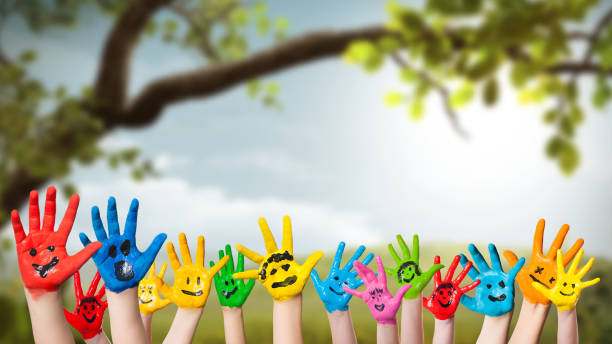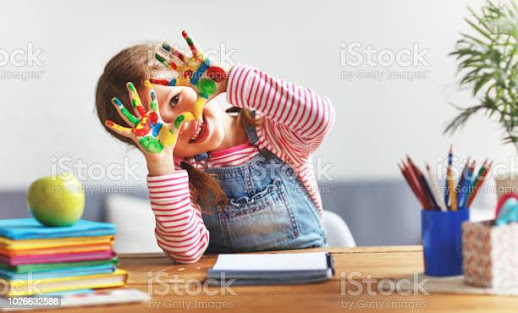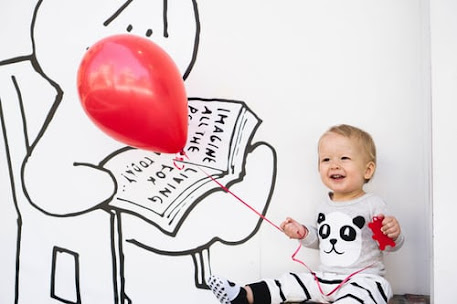10 Fun activities to develop hand function in children with ASD
It was the month of December. I was in my 8th grade preparing for my half-yearly exams making notes. The weather was so cold that after writing just one page, my fingers became numb. I couldn't hold the pen properly since my fingers couldn't feel the touch of the pen. My writing was very slow & clumsy since I had to repeatedly adjust the pen in my fingers & hold it tighter to feel the pen in my fingers...
The main function of the human hand is to manipulate objects to achieve a goal. The ability to grasp objects & manipulate them using our hands is very vital for performing our daily activities.
In my previous articles, I have mentioned many activities on how to develop the functional grip to hold a pencil, to develop fine motor skills, & to develop proximal stability in children.
Most of those activities can be used by children with some control of the small muscles of the hand. In this article, I will be listing some very basic activities that can be easily practiced at home even for kids as young as two-three-year-olds to develop their gross grasping & some control over the small muscles of the hand. These activities can be used by children with special needs like Sensory processing disorders(SPD), Autism spectrum disorders(ASD), Downs Syndrome, Developmental Delays, or any younger child whose hand functions are in the developing stage. Most of the activities are basic to develop gross grasp patterns with a few activities focusing on fine motor strength as well.
Why is the development of hand functions important in a child's life?
We use our hands in almost all the activities we do everyday starting from holding the toothbrush & moving it inside the mouth while brushing our teeth in the morning till switching off the light switch before going to bed.
Although we do these tasks very easily, the capacity to use the hand in everyday activities it requires a lot of coordinated movements of the large & small muscles of the hand, anatomical integrity, sensation, coordination, strength, praxis, body awareness, and dexterity.
A more skilled hand function is required in activities like playing guitar or making a rangoli or painting.
Why is hand function affected in children with special needs?
Since children with any special needs mostly have sensory issues(difficulty processing touch & proprioception sensation) or motor difficulties or delay in development of gross motor & fine motor milestones, their hand function is affected as well.
The difficulties faced by different children might vary from a little impairment which doesn't affect their daily activities much to more severe impairments where the child has difficulty even grasping a large object in hand....
Imagine if you are asked to wear rubber gloves & write an essay or paint a picture. Would you be able to do that?
Why is it so difficult? It's because the sensory information that you get from the touch of the pen or paintbrush is blocked by the rubber gloves making it really difficult for you to manipulate those objects(pen or paintbrush) in your hand to do your task efficiently.
Similarly, since a child with ASD has difficulties processing sensory inputs, manipulating small objects in hand can be very difficult for him.
A child with Downs syndrome might have low muscle tone which makes it very difficult to hold objects tightly & manipulate/control them efficiently in hand.
How to enhance the development of hand functions in children?
I will be describing some simple activities that you can easily do at home to develop the hand functions in children so that they can perform their daily tasks independently & comfortably.
These activities can be used by children with special needs like children with ASD, SPD, Developmental delays, Down Syndrome, who have difficulties in using their hands efficiently to perform their daily activities. These can also be used by small kids who have started to use their hands to manipulate objects of different sizes, shapes & textures.
Find out some simple activities to develop/enhance the fine motor skills of children (for more skillful use of small muscles of hand like writing, or playing piano) in👇
https://www.blogger.com/blog/post/edit/3822183011638689152/1089094259745849312
10 Fun & Simple activities to develop hand functions in children
😄Using water bottles
Bottles filled with water can be used in different ways to develop & strengthen the grasp of your child.
These activities can help to:
➧Strengthen muscles of the hand(essential for gripping objects)
➧Strengthen muscles of the arm & shoulders/proximal stability
➧ Develop coordination of the hand & arm movements (essential for writing)
➧ Provides tactile & proprioceptive inputs to the hand
👉 Carrying water bottles
Make this activity fun by adding a short obstacle course
Steps:
1. You can make a small obstacle course using small stools & cushions.
2. Keep a few water bottles at one end
3. Ask your child to carry a water bottle, cross the obstacles(climbing up & down the small stool), (walking on the cushions) & put it on the other end.
Then repeat for another bottle.
👉 Lifting water bottles
You can simplify the above activity by just putting some water bottles on the floor & asking your child to lift them up one by one & keep them on the table.
👉 Pouring water from & into water bottles
Although this activity seems simple to us, it requires a lot of coordination of hand & arm movements & a lot of attention.
Steps:
1. Pour water from a bottle into glasses.
You can use large bowls or even buckets if your child hasn't developed the strength & coordination to pour water into a glass.
You can give small bottles or large bottles of water according to the age & level of your child.
2. Pour water back from a glass into a bottle.
Again, you can use a large-mouthed bottle or a jar instead of a bottle to make it easier.
😄Fill the bottle
This simple activity can be very beneficial to-
➧ Develop a good grip strength especially required to hold many small objects like while eating rice/dal.
➧ Develop control of finger movements
➧ Eye-hand coordination
Materials needed:-
- An empty water bottle
- A bowl of raagi/raajma/sand
😄Use of sponges
Kids love this fun activity & it is very beneficial to develop grip strength.
Materials needed:-
- A dishwashing sponge or a towel
- A bowl of water
😄Pulling & pushing heavy objects
Pulling & pushing heavy objects can help to:
➧Develop proximal stability.
➧Strengthen the muscles of the hands.
➧Provides a lot of proprioceptive inputs to the hands, arms & the whole body as well.
➧Helps develop coordination of use of both hands to complete a task especially while pulling with a rope using alternative hand movements.
Steps:
1. You can ask your child to push heavy objects like tables, cartoons filled with objects, or any other objects heavy for them.
For pulling;-
1. Use a rope to tie to any heavy object like
- The leg of a stool with some objects placed on it,
- Bucket half-filled with water
- Any box or jars with objects to make it heavy, etc.
😄Opening & closing caps
You can use bottles with large caps or small caps. You can also use jars(having caps with a larger diameter) for this activity.
According to your child's age & level of hand functions, make it easier by practicing opening large-caps & jar caps first.
Then, gradually you can give smaller caps of bottles to open & close.
Opening & closing caps can enhance the use of the thumb in opposition to the hand which is the basic hand function we use in most of our daily activities.
😄Rubber bands activity
This is a great activity that helps to develop pincer grasp in kids. A very simple activity to increase finger strength and can be used in many variations as well as focusing on different areas.
Can be given to toddlers. They love this activity.
👉 Put Rubberbands around a bottle
Materials needed:-
▪️ Any water bottle or tin can or anything cylindical.
▪️ Lots of colorful rubber bands
Steps:1. Use a bottle or anything cylindrical.
2. Help your kid to pick up 1 rubber band,
pull it with his fingers and put it around a bottle...
3. Then remove them one by one.
(Make sure he uses his two fingers {Thumb & index} to pull the rubber bands while putting around the bottle and removing them. )
Or Thumb, index, and middle fingers for younger kids.
😄Tear & Paste
This activity is enjoyed by all kids & it is very beneficial in multiple ways. You can use different coloured papers for this activity to make it more fun & interesting.
This activity helps to:
➧Strengthen small muscles of the hand
➧Enhances fine motor control
➧Works on eye-hand coordination
😄Crumpling Newspapers
Kids enjoy this activity a lot & this simple activity can be very helpful for strengthening the muscles of the hand.
👉 Make paper balls
Steps:
1. Cut/tear large newspaper into some pieces(two-three) depending on the age & level of your child.
2. Ask your child to crumple those pieces to make paper balls.
3. Count how many paper balls you have made.
4. You can make it more fun & interesting by playing a game with your child- who can make more number of paper balls.
👉 Paste paper balls
You can make any simple drawing & ask your child to make paper balls & paste those inside the picture similar to the tear & paste activity.
😄Activities with Clothespins
Clothespins are the best tools when it comes to pencil grip!
They are easily available, great for developing a three-finger grasp for pencil holding, and can be used in various ways!
Materials needed:-
▪️ Colorful clothespins
▪️ Thin cardboard
▪️ Colours (sketch pens /markers)
▪️ Rope
👉 Press the clip
Use clips( clothespins) to press and fix on a thin cardboard .
Then press and remove one by one.
👉Match the color
➧ To make it more fun, you can make some circles of different colours on a chart paper or thin cardboard.
Then, ask him to fix the same colour clips over the respective colour circles.
👉Clip ABCCut 26 pieces of a chart paper and write A-Z on them using sketchpens or marker.
Tie a rope at shoulder height of your kid. Ask him to find out and clip A-Z in a sequence.
😄Playdough activity
Using playdough has multiple benefits for kids. Kids love to use it & you can keep them busy for hours with this thing.😄 You can also use kneaded “atta" as a variation.
Materials needed:-
▪️ Playdough (any colours)
▪️ Any small objects (coins, beads, beans, small pegs )
▪️ If you don’t have beads/small pegs, you can use green peas/raajma beans/chickpeas also.
▪️ Pencil
👉 Find the hidden treasure
Steps:-
1.Make a spherical shape playdough.
2.Insert some small beads/coins in it.
3.Ask your kid to pinch the playdough with his fingers, find the bead, and name its color.
It’s an excellent activity to develop your child’s finger strength and fine motor skills.
➧ If beads are not available, you can put rajma beans/chickpeas inside the playdough & ask your child to remove them one by one.
👉 Pinch the playdough with 3 fingers
Steps:-
1. Knead the playdough or atta into a cylindrical shape.
2.Ask your child to use his three fingers to pinch off small pieces of playdough.
3. Then, roll them into small circles.
Keep doing till all the playdough is finished.
👉 Making different shapes/letters/numbers
Roll the playdough into small cylindrical pieces. Ask your child to make different shapes/letters/numbers with it.
Let your kid use his/her imagination and make anything out of the playdough.
It’s an excellent fine motor activity that builds their imaginative skills, attention span, eye-hand coordination as well.
All of the above activities are fun, easy to practice at home & are very effective to develop, strengthen & refine the hand functions of your child. The daily activities that you & your child participate in can be much easier if a child has good gross motor & fine motor skills.
Try them out!
Enjoy reading!
Happy parenting to all my readers.😄
About the writer :-
The writer’s name is Abhipsa Parida. She is an occupational therapist specialised in pediatrics and has been handling kids with special needs since 5 years. She is quite experienced and skillful in observation, assessment and planning intervention for kids with special needs. She uses evidence based practice and is very creative and updated in her approach while handling kids with special needs. She has her own clinic in Bhubaneswar and has handled many kids of different age groups with varying needs.
If you have any queries, you can mail them at abhipsaot21@gmail.


















Very helpful tips! Thanks for sharing.
ReplyDeleteMy pleasure 😄😄
DeleteGood Information 👍👍
ReplyDelete🙂🙂
DeleteGood information mam
ReplyDelete🙂🙂
ReplyDelete